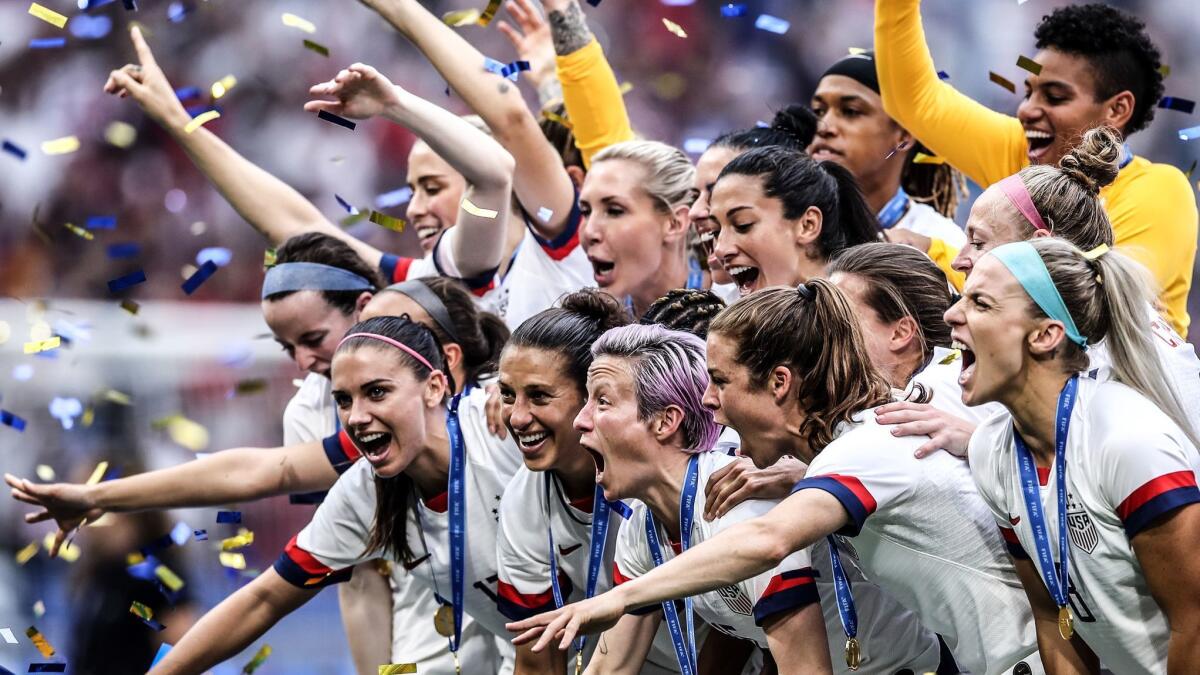Captivated by the U.S. women’s soccer team victory? Thank Title IX

- Share via
Sunday’s World Cup victory for the U.S. women’s national soccer team was entirely due to the hard work and talent of the players on the field. But long before they were born, civil rights advocates and legislators were hard at work clearing their path to success.
Passed by Congress nearly 50 years ago, Title IX prohibited educational institutions receiving federal funding from discrimination based on gender. The legislation ensured the right of students to learn in an environment free from sexual harassment, and guaranteed pregnant and parenting teens breastfeeding accommodations. But the best-known feature of Title IX was its requirement of equal athletic opportunities for girls and boys.
This was a novel concept in the 1970s, and it did not go unchallenged. Lawsuits were filed by the NCAA and others demanding exemptions from the athletic provision. Their arguments hinged on an assumption that girls were not as interested in sports as boys, so schools should not be required to hire coaches to serve them or provide equal practice space. But judges determined — and history has shown — that the argument was simply untrue. When sports are made available to girls, they embrace them. The year Title IX was passed, there were 700 girls playing soccer on high school teams, according to a participation survey of the National Federation of High School Assns.; today, there are 390,000.
They — like all women — deserve to be paid and treated fairly. And they are embracing the longstanding tradition of legal advocacy to move the ball forward.
At roughly the same time the U.S. was passing Title IX, women’s rights movements around the world were succeeding in lifting bans on women’s soccer leagues. Several countries — including England, Brazil and Germany — had barred women from the sport on the premise that playing soccer could damage their ability to bear children. While eliminating the prohibitions was a step forward, this alone was not enough to generate an influx of young athletes; the sport was technically allowed but with limited investment, participation was anemic.
The U.S. took a different tack, and it reverberates in the world of women’s soccer today. Title IX didn’t merely allow women to play; it required opportunities be made available to them.
And the players poured in.
Between the year Title IX was passed (1972) and the first Women’s World Cup (1991), the sport saw a 17,000% increase in U.S. girls playing on high school soccer teams, according to the National Federation of High School Assns.
Some of these girls have grown up to be among the finest athletes in the world, and they are now in position to demand another kind of gender parity: pay equality.
Twenty-eight members of the U.S. Women’s National Team have filed a lawsuit against the U.S. Soccer Federation alleging they are paid less than their male counterparts, despite doing the same work (and despite their impressive record of four World Cup championships and four Olympic gold medals).
Pay inequality is familiar territory for female athletes — the starting salary for a WNBA player is less than $42,000 while men begin at nearly $600,000. The road to “equal pay for equal work” has been rocky not only for athletes but for working women across the country. The idea gained traction following the influx of women entering the workforce during WWII, yet it was nearly 20 years before the federal Equal Pay Act was passed — thanks to vocal women’s advocacy groups as well as key women in the Kennedy administration and Congress.
But just as lifting women’s soccer bans alone failed to immediately ignite the sport, the Equal Pay Act has yet to close the wage gap. As the thunderous chants of “Equal Pay!” after the women’s victory on Sunday suggest, it is a maddeningly persistent reality.
Enter the Fray: First takes on the news of the minute »
Women today generally earn an average of 80 cents for every dollar earned by a man, and women of color experience a much wider gap; Latinas earn just 53 cents per dollar a white man makes. This economic inequality compounds over a lifetime. Women are less able to accrue savings and investment income, and life-long discrimination is reflected in their reduced Social Security checks. The impact is tragically logical: two-thirds of older adults living in poverty are women.
But progress is being made. Equal pay laws have been strengthened by courageous women bringing legal challenges to expose weaknesses and loopholes. The recent lawsuit filed by U.S. Women’s National Team members refers to “institutionalized gender discrimination” — no minor issue to combat. But the players are joining the legion of advocates who recognize that the pursuit of gender equality must be a proactive one.
Change usually happens incrementally. Some of the athletes who played in the first Women’s World Cup in 1991 have shared their memories of the playing conditions back then. They stayed in hotels where the toilets didn’t work, were served spoiled food and played back-to-back games with little rest in between.
Today, the women’s soccer players enjoy upgraded accommodations and gear, but they aren’t settling for “better than it was.” They deserve more than just a chance to play. They — like all women — deserve to be paid and treated fairly. And they are embracing the longstanding tradition of legal advocacy to move the ball forward.
Betsy Butler, a former member of the California Assembly, chairs the California Commission on Aging and is executive director of the California Women’s Law Center.
More to Read
A cure for the common opinion
Get thought-provoking perspectives with our weekly newsletter.
You may occasionally receive promotional content from the Los Angeles Times.









